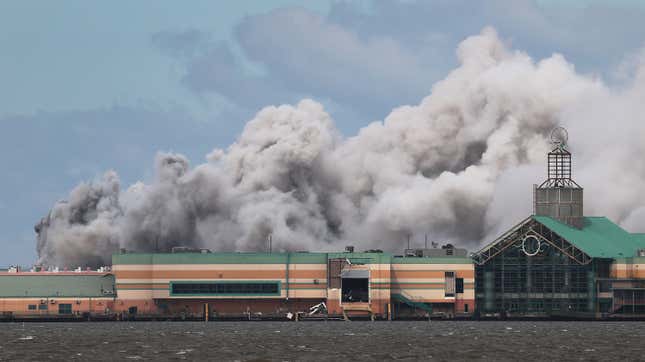
Hurricane Laura’s devastation is becoming clear as light spreads over Gulf Coast. The storm made landfall as a powerful Category 4 hurricane in Louisiana early Thursday with “catastrophic storm surge, extreme winds and flash flooding, according to the National Hurricane Center. When it made landfall, Laura tied the record for the strongest storm to hit the Louisiana coastline.
The storm hit in the heart of petrochemical country, raising concerns even before landfall of leaks and spills that seem to unfortunately be coming to pass. A chlorine leak from BioLab facility near Lake Charles, Louisiana on Thursday morning sparked horrific fires in surrounding refinery facilities. Storm chaser Jeff Piotrowski tweeted a photograph of a cloud drifting across the highway. “911 is aware they are overwhelmed,” he wrote. Chlorine poses a major health hazard to people, adding another layer of danger for residents who were unable to evacuate.
“Local officials may have turned off all air quality monitors in the area, arguing that they’re ‘too expensive’ to replace, but we can still smell the chemicals,” Juan Parras, the founder and CEO of environmental justice group TEJAS, said, referring to petrochemical facilities in Texas that also took a beating from the storm. “Fossil fuel and petrochemical corporations are more worried about protecting their profits than our health.”
The damage was hardly limited to these facilities, though. Photos show homes and businesses in Lake Charles and other communities on the Louisiana-Texas border decimated by the rains, relentless wind, and storm surge. Skyscrapers in Lake Charles had their windows completely knocked out. Emergency responders were reportedly forced to wait hours before they were able to check the extent of the damage done by the storm.

Another danger locals are facing is downed power lines. Utility companies reported that about 404,000 customers in Louisiana and another 104,000 in Texas were without power Thursday morning, which could hugely complicate the evacuation process for those who were forced to or chose to shelter in place.

Before the 150 mph winds began, local officials called for hundreds of thousands of people to evacuate. Gut-wrenchingly, Louisiana leaders called for those who did not do so to write their names and other identifying information on pieces of paper and place them in Ziploc bags to keep in their pockets. Late Thursday morning, a 14-year-old girl in Vernon Parish, Louisiana, was killed by a tree falling on her home, making Laura’s the first confirmed U.S. death.
“Praying that it does not come to this,” the Vermilion Parish Sheriff’s Office said in a statement.

There’s no good place for a deadly storm to hit. But Hurricane Laura comes with particular dangers, because it’s pounding a hub for petrochemicals and refineries—essential components of the death cult of fossil fuels which got us into this climate catastrophe in the first place—which can ooze scary chemicals into floodwaters and create other hazards. Over 20% of U.S. refining capacity is located within the Laura’s potential path. By Tuesday, 84% of the Gulf’s oil supply had shut down in preparation, but even a vacated plant can catch fire or spring a leak, which poses a grave threat to frontline communities in the area who are already facing “unsurvivable” storm surges.
Many residents in the region are still recovering from storms of years past, like Hurricane Harvey, which ravaged Texas just three years ago.

“There has been just flood after flood the past few years,” Samantha Montano, an assistant professor of emergency management at Massachusetts Maritime Academy who has studied Texas flooding for nearly a decade, said in an interview with Earther on Wednesday before the storm hit. “2015 Memorial Day Flood. You have Tax Day Flood and another flood in June 2016. Then you have Harvey on top of that. So what we’re seeing in these communities, you get trapped in this cycle of recovery. People can’t recover from the last flood before the next one comes.
The storm also comes almost exactly 15 years to the date after Hurricane Katrina pounded the Gulf Coast. Katrina was one of the worst climate disasters of last century, and Laura brought even stronger winds and more dangerous surge.

There’s no question that the increasing severity of hurricanes is linked to the climate crisis, which major corporations have fueled by continuing to spew greenhouse gases into the atmosphere. That means this devastation was, at least in part, avoidable.
“The rapid strengthening of this storm and the predicted “unsurvivable” storm surge are part of an escalating pattern of climate chaos,” John Fleming, a scientist with the Center for Biological Diversity’s Climate Law Institute, wrote in an email. “Climate change is causing both warmer sea surface temperatures and sea level rise, a perfectly horrible recipe for disaster in the form of severe hurricanes.”
It also means we can still mitigate this horrible onslaught of worsening storms by halting all fossil fuel extraction and drawing down our carbon emissions.
